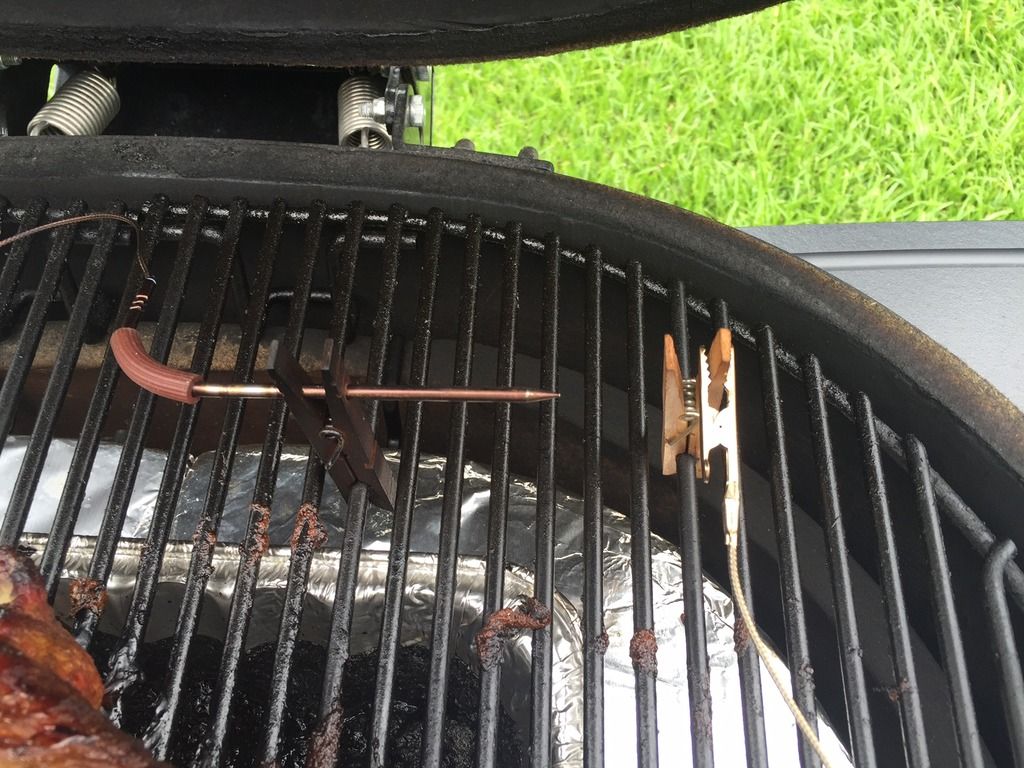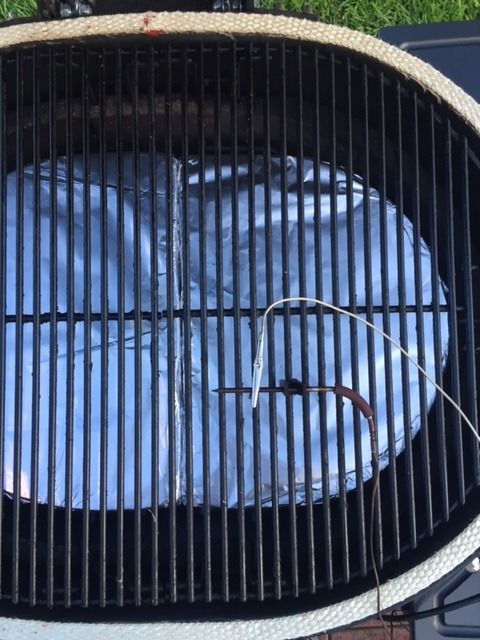Paul Nederveen
TVWBB Member
Hi folks,
I tried my first HM controlled cook this weekend. It worked and it didn't work. My setup is as follows:
Primo Oval XL cooker.
HM 4.2.4
2x iGrill Thermistor probes (from a still working iGrill bluetooth temp monitor)
1x Perfect-Prime TL0500 K-Type Sensor alligator clip seen here.
Micro Damper by Steve into a homemade damper plate.
I got the smoker going with the HM attached, set point at 215 (set for 225 later). Everything seemed stable, and I put the shoulder on to start smoking. So far so good. The HM held the temp perfectly around the set point and I ramped it after the first 6 hours.
After 12.5 hours the meat hit 170.4 and started falling. I figured it was a stall. Meat temp started dropping and kept dropping for the next 2 hours! I raised the set point a bit and then I got worried and started doing some investigation. My built in grill thermometer was reading only 200 degrees. I expect it to be a bit lower but 25 was a big gap.
I put the spare iGrill thermistor probe in next to the TC probe as shown in pic:

The grill thermometer and the thermistor registered the same 200F. The difference ranged from ~25 degree (TC=225, TM=200) up to over 60 degree difference (TC=~315, TM=~250). For sanity I plugged the same thermistor probe into the iGrill and the HM and they were exactly the same temp.
I had already calibrated my TC in freezing and boiling water. Stock settings for voltage and 0 offset. I checked it again today in boiling water and was reading 212-213 and .502V on the output of TC circuit. (as per this thread)
I need help on understanding why the TC seemed to have an increasing error and what I should be doing different.
Thank you all!
P.S. The pork was safe to eat and tasty but not as tender as I would have liked...beer helped me calm down eventually.
I tried my first HM controlled cook this weekend. It worked and it didn't work. My setup is as follows:
Primo Oval XL cooker.
HM 4.2.4
2x iGrill Thermistor probes (from a still working iGrill bluetooth temp monitor)
1x Perfect-Prime TL0500 K-Type Sensor alligator clip seen here.
Micro Damper by Steve into a homemade damper plate.
I got the smoker going with the HM attached, set point at 215 (set for 225 later). Everything seemed stable, and I put the shoulder on to start smoking. So far so good. The HM held the temp perfectly around the set point and I ramped it after the first 6 hours.
After 12.5 hours the meat hit 170.4 and started falling. I figured it was a stall. Meat temp started dropping and kept dropping for the next 2 hours! I raised the set point a bit and then I got worried and started doing some investigation. My built in grill thermometer was reading only 200 degrees. I expect it to be a bit lower but 25 was a big gap.
I put the spare iGrill thermistor probe in next to the TC probe as shown in pic:

The grill thermometer and the thermistor registered the same 200F. The difference ranged from ~25 degree (TC=225, TM=200) up to over 60 degree difference (TC=~315, TM=~250). For sanity I plugged the same thermistor probe into the iGrill and the HM and they were exactly the same temp.
I had already calibrated my TC in freezing and boiling water. Stock settings for voltage and 0 offset. I checked it again today in boiling water and was reading 212-213 and .502V on the output of TC circuit. (as per this thread)
I need help on understanding why the TC seemed to have an increasing error and what I should be doing different.
Thank you all!
P.S. The pork was safe to eat and tasty but not as tender as I would have liked...beer helped me calm down eventually.
Last edited:





